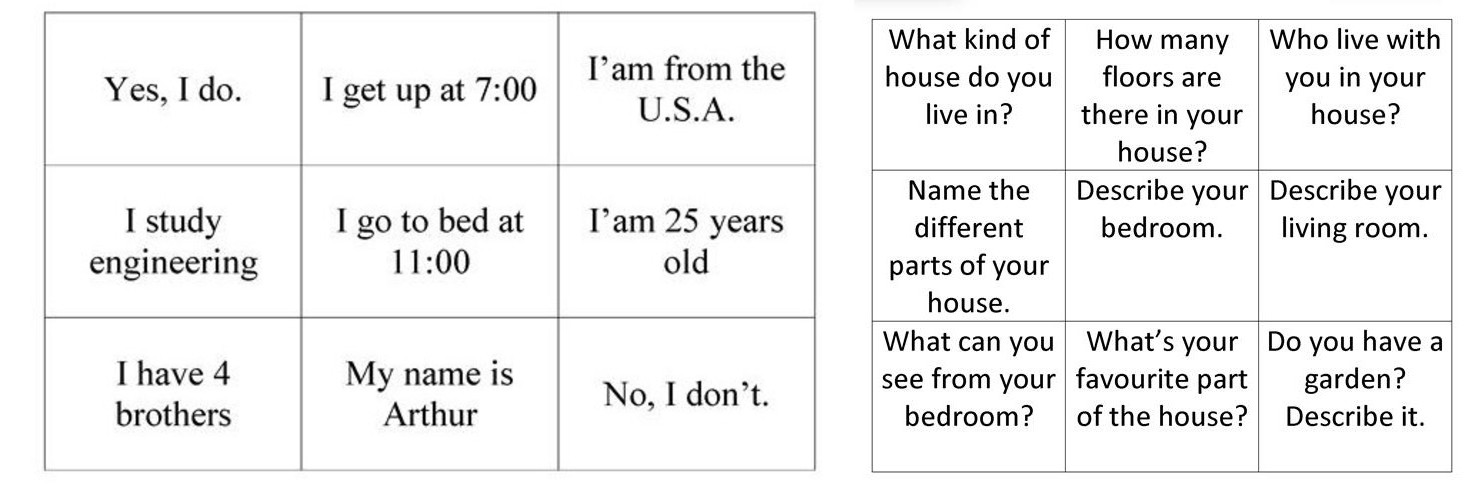Tic-tac-toe, better known as noughts and crosses, is one of the games that can be easily adapted to English classes. It’s fun and challenging. What is important is that the noughts and crosses game is a great way to practice different skills by varying lessons and making them more interesting. Besides, the game helps to engage and hold the learners’ attention of all ages.
We’ve already written about how to use it with primary learners. In this article, you will find more ideas which you can use with teenagers and adult students and for online classes as well.
Tenses
Idea1: Prepare a grid of nine squares with different tenses and special symbols indicating different types of sentences (positive, negative, and questions). On the other side of the paper write the appropriate number for each square and cut them. If you use abbreviations, make sure that your students are familiar with them, for example, for Present Continuous Negative we use Pr. C. -.

Open the online version of the game, demonstrate your screen, and mark O or X for your students, or ask students to draw a grid to play.
If you work with a group of students, divide them into two teams. One of them will play for Noughts, the other one for Crosses. Decide which team starts first. Have that team choose one of the squares by saying the number. Show them the square with that number, for example, students choose number 5, you show them the square P.C ?
The task is to make a sentence with the corresponding tense into 20 seconds. Also, explain that both teams should be ready with the sentence. If the first team makes a mistake, the second will have a go and have a chance to fill the square with its symbol. Then ask the first team what’s wrong with its sentence.
You can also play this game in individual lessons. Ask which symbol students want to be and start the game. Make mistakes on purpose so they have a chance to work with different tenses.
Idea 2: Prepare 9 pictures for each square. Decide which tense you want to practice with students, for example, Present Continues. Show the grid and ask them to choose one of the pictures. They describe the activity on that square by making sentences with the tense. If they say it correctly, they put their respective O or X in the box.

Idea 3: Choose which tense you want to revise and write personal pronouns or subjects into the grid. Students make sentences by using them and the chosen tense.
Idea 4: To contrast tenses, write time expressions and ask students to make a sentence. You can add a verb, so students can also practice, for example, irregular verbs in past simple or present/past perfect.
Asking and answering questions
On each square of the grid write a question or an answer. Students should whether answer questions or make questions.

If you work with answering questions, you can also write different topics on the square instead of questions, for example, sport, nature, pronunciation, grammar, cinematography, etc. Prepare questions for each of them. When students choose the topic, read the question for that topic. Or ask students to speak one minute about it.
Vocabulary
Idea 1: Choose a topic and elicit theme words from students. Write them on the grid and ask students to make a sentence or give a definition.
Idea 2: Choose nine words or phrases that you’d like to practice with your students. On each of the nine squares write their explanations by using the rules for the Taboo game or put pictures that represent them. Students choose the square and try to guess the word.
Functional language
Write some phrases and ask students where they might be used. Or you can write the place and students say the phrases that can be used there, for example, at the restaurant — Could I have the check, please?
Spelling
Noughts and crosses game also allows revising spelling. Give the base form of anything you want to practice with your students and ask them to write the needed form. For example, the words, which are irregular in the plural.
Speaking
Write nine words on each square. They can be adjectives, nouns, phrasal verbs, anything that you want to revise. Divide students into pairs. The idea is to tell a story by using the words in the grids. It forces students to listen to what is being said and at the same time think of how to continue the story themselves to make it logical.
Tic Tac Toe for summative assessment
This strategy allows students to choose how they should be assessed at the end of the lesson. The teacher provides nine options for assessment. They must include different levels of understanding and the ways how to do it. For example, to check students’ basic knowledge of a concept they can do such activities as defining or listing, to check their comprehension, they can summarize, contrast and compare, etc. Students need to complete three assignments that make the “three in a row”.

Play Noughts and Crosses and make revisions with your students!






 Олеся Яресько
Олеся Яресько 
 Диляра Биктагирова
Диляра Биктагирова 


